|
This is the BFI's fourth Bumper Box Set from the archives of the Children's Film Foundation (CFF). For many Brits of a certain age, Saturday mornings meant children's picture shows at your local cinema, and often these included a CFF production, usually a short feature (or three-reeler, in old money) of fifty to sixty minutes, plus serials, short films and documentaries. Even if you didn't go to the picture shows, you often saw extracts from CFF films on television programmes like Screen Test. Children's cinema matinees began in the late 1920s, but soon there was a call for British productions to show to British children, rather than potentially unsuitable American films. The Children's Film Department became the Children's Film Unit, which in 1951 was replaced by the CFF, which towards the end of its life became the Children's Film and Television Foundation. The CFF continued until the mid-1980s, when the abolition of the Eady Levy (which took part of cinema box office takings and put it towards British film production), the rise of home video and Saturday morning television shows such as Tiswas and Multi-Coloured Swap Shop made the picture shows obsolete. Over the years, the CFF provided a place for filmmakers to learn their craft, and gave some child actors an early break. On the other hand, some filmmakers ended their careers there and many of the children didn't carry on to adult acting careers. For more details of the CFF's history, see my previous review of Bumper Box Volume 3, which like the current release contains nine films on three DVDs.
Even though the films were made by various companies on behalf of the CFF, some patterns do emerge. No doubt aware that both boys and girls would be watching, many of the films have ensemble casts, and when there is one clear lead child character, he or she would likely be balanced by a featured supporting character of the opposite sex. Given that getting boys to watch material with girl protagonists is often assumed to be a fraught issue, there are still examples of female leads here. Unusually, in Gabrielle and the Doodleman, Gabrielle is the only child in the film and doesn't have another one, boy or girl, to bounce off. The Big Catch is another exception in that it's an all-boy affair.
As anyone who did see CFF films at their local cinema would now be at least in their later forties, it's hard to avoid the suspicion that this box set is more likely to be watched by nostalgic adults and specialists in children's film, rather than today's children. Expectations of pacing will be different now, and the fact that CFF productions were black and white until the mid 1960s. Some language and social attitudes are certainly those of a different age, not forgetting that for the most part the principal casts are made up of middle-class stage-school kids speaking in RP accents. But the best of the films are pacy and still entertaining and act as time capsules of the times they were made.
This release comprises nine films, three per disc, presented in and reviewed by me in chronological order.
The dog in question is called Boffin, and he gets to share the title card in the opening credits. In 1953, we're in a run-down housing estate still showing the signs of wartime damage. A group of children keep animals in the garden of an empty house, unaware that the premises is being used by a gang of jewel thieves.
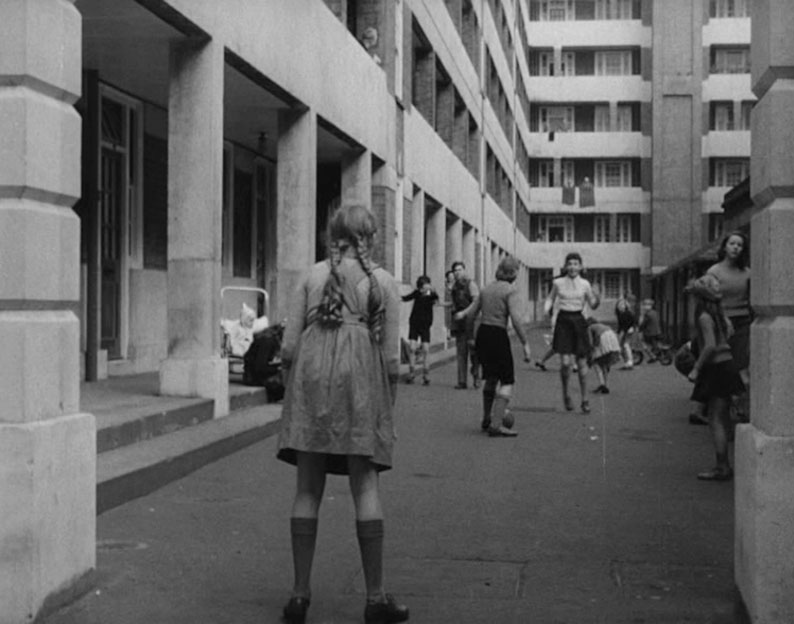
The credits of this film are surprisingly high-powered. Producer Peter Rogers went on to make the Carry On series and director Ralph Thomas was four years and seven previous feature films into a career which would take him on to the Doctor films which packed in British audiences later in the decade. The adult leads are Kathleen Harrison as a pet-shop owner and George Coulouris as a grumpy caretaker. Not one of the strongest-plotted films in this set, it's nevertheless entertaining and won a prize at the Venice Film Festival.
Something of a Cold War-era tale this, with delegates from the country Francovinia not being what they seem. The real delegates have been kidnapped and a gang of crooks is posing as them in an effort to steal an airliner which the delegates were in England to buy. Helping to guard the plane are air cadets Anne (Diana Day), Fred (Fella Edmunds) and John (Michael Macguire), and they get abducted along with the plane…
There's a notable name on the credits of this film – director Don Sharp, making his feature debut. Sharp was born in Australia in 1921 but had arrived in England in 1948, one of quite a few Australian directors and actors in the UK for greater opportunities than were available back home. Sharp, who co-wrote the script of The Stolen Airliner with John Pudney, from the latter's story Thursday's Adventure, went on to a long career in film and television, being responsible for several notable Hammer films. The Stolen Airliner is a pacy thriller, which makes good use of its child cast, the fourth lead role being the much younger Kitty (Nicola Braithwaite). The film was well received at the time, though eyebrows were raised at the children being seen to drive cars.
In a small Midlands town, Jim Fenn (Michael Crawford) aspires to play the cornet in the local Colliery band. The trouble is, he doesn't own such an instrument, but his rival Tony (Martyn Shields) not only has one but is being coached by a band member. Conductor Mr Duff (Peter Butterworth) takes a shine to Jim and helps him learn. Soon, there will be a competition, and Tony goes to great lengths to sabotage Jim's chances…
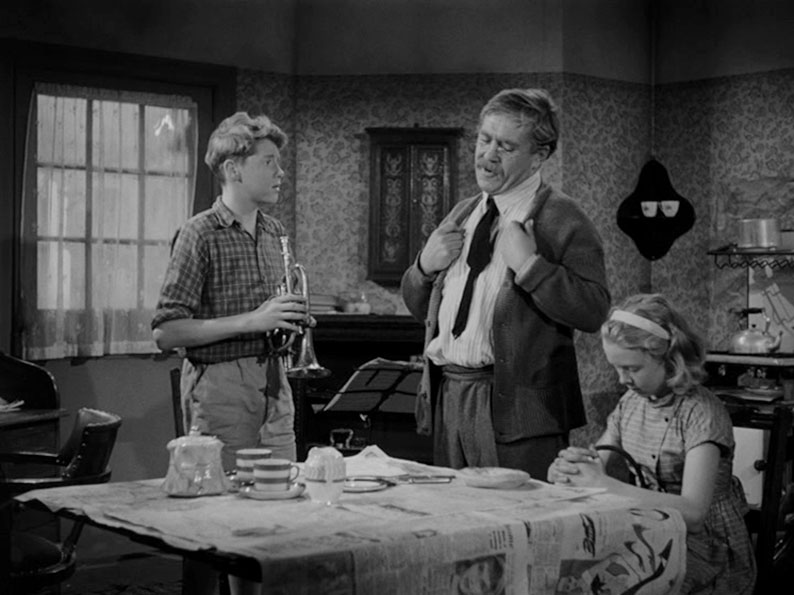
Despite its non-Home-Counties setting (supposedly Midlands, though some of the accents are more northern), Blow Your Own Trumpet was actually shot at Merton Park Studios. Sixteen-year-old Michael Crawford had previously appeared in another CFF production, Soapbox Derby, released the same year, 1958. Before his film, television and stage stardom, he gives a confident performance. In a couple of ways it anticipates his Frank Spencer a decade and a half later, such as the accidental trouser-dropping during a climactic scene. Given that he is one of the CFF's young cast who did go on to an adult career, it's notable that he isn't always the centre of attention, as Jim's sister Helen (Gillian Harrison, who had a four-year career in the 1950s but didn't continue to act) has almost as much to do to drive the plot. As the main adult, Peter Butterworth, who appears elsewhere in the CFF's output as Dickie Duffle in several short slapstick comedies, underplays nicely.
The Missing Note, which appears to have had the perhaps too clever punning working title of Gallop for Piano, is from 1961, written by prolific CFF writer Mary Cathcart Borer from a story by Frank Wells and directed by Michael Brandt. We're still in 1961 post-war black and white Greater London (Walton-on-Thames, Weybridge, Twickenham), but there's a sense that the makers are trying to move outside the middle-class bubble, or echo chamber, some of the other CFF films seem to inhabit. So we have children brought up by a single mother and not much money to go round. The family can't buy a piano for talented Joan (Heather Bennett) to play because they've just sprung for a television set. This is still inevitably a product of a time on the other side of the social changes to come in the 1960s, but it's a good attempt to be relatable to their audiences, who were from all over the country and all social groups.
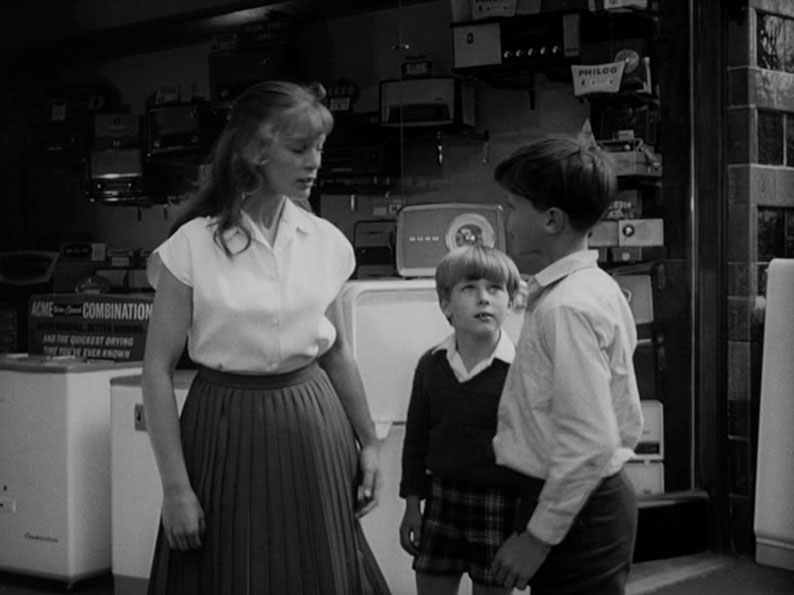
It's a bit unlikely that a piano with a broken key would get through undetected to be played in concert, but that would blow part of the plot where our young ensemble cast, here a girl and two boys, tackle a gang of jewel thieves who have hidden their loot in said piano. Of the young cast, only John Moulder-Brown went on to an adult acting career. Brandt only has one other directing credit on IMDB, but in the editor's chair was John Glen, who did go on to edit and direct, with five James Bond films to his name in the latter capacity.
Black and white became commercially obsolete, in wide-release English-language films at least, in the later 1960s. The CFF made films in black and white up until at least 1967 (see Calamity the Cow in Volume 3) but it's a year later and we're on the north-west coast of Scotland (Ullapool, Lochinver, the Summer Isles) and we are in colour. In a port village young Ewan (David Gallacher) is put out when Lindsay (Ronald Sinclair) comes to stay. Lindsay plans to capture one of the wild ponies that roam on a nearby island, which has a jetty in a dangerous state of disrepair.
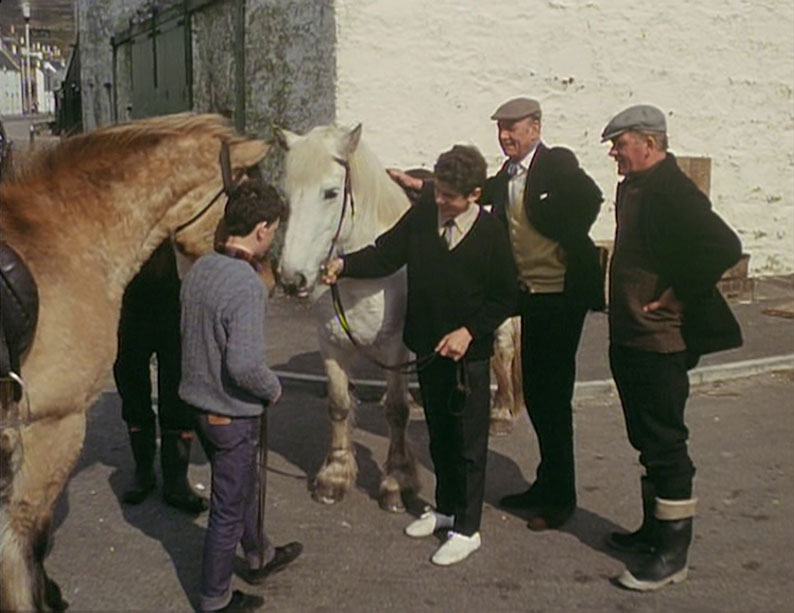
Directed by Laurence Henson, The Big Catch is somewhat in thrall to Edward McConnell's camerawork, as this is one of the blander, less engaging films in the set. Production company, cast and crew are all Scots, though the accents on display won't be too hard-going for non-Scots. (Just as well, as there are no subtitles available on these discs.) Henson wrote the script with Charles Gormley, who later became a director as well as a writer (Heavenly Pursuits, Living Apart Together) as well as playing the lead role in another film out on BFI Blu-ray, Maurice Hatton's Long Shot. The Big Catch is pleasant, especially to look at, but underwhelming.
Boy inventor Blinker (David Spooner) is so-named to everyone, due to his giant-sized specs; we never find out the name on his birth certificate. Even his parents call him that, which seems a little harsh. (Well, it's a step up from the likes of Four Eyes.) Encouraged by his mother to spend less time on his inventions and to play with other children, Blinker finds himself in the middle of a rivalry between local football team The Strikers and the Masons gang. And meanwhile, three criminals, who go by the names North, South and East (Brian Forster, Bernard Bresslaw and Milton Reid, respectively) are out to steal the top secret Pulsar Crystal X, which Blinker's professor father has been working on.
Made in 1971, this film was directed by Jack Stephens (his debut after previously being an art director), who provided the story for David Ash and Harold Orton's script, this plays more for broad slapstick than thrills and spills, as our intrepid heroes (Blinker's sidekick being Glenda, played by Sally-Ann Marlowe) sort out the mess incompetent adults have made and put things to rights in time for tea.
Three years on from Blinker's Spy-Spotter, another excursion into SF/fantasy by the CFF. Uncle Charlie (John Bluthal) is working on a time machine, which accidentally sends young David (Kim Burfield) back to the Middle Ages, and a land which is being terrorised by Dormantus the Dragon. David helps young Lady Eleanor (Debbie Russ) and sorcerer Astrolabe (Tim Barrett) but inadvertently bring Dormantus back with them to the present day…
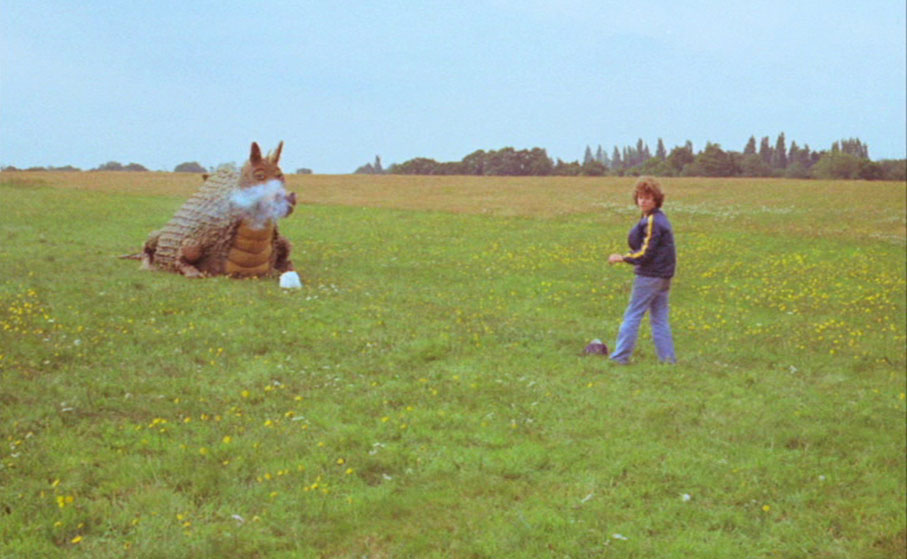
The Flying Sorcerer seems an idea not up to the budget available – the Middle Ages scenes are noticeably underpopulated and as for Dormantus...well, the BBFC consumer advice sums it up by saying that the effects are "dated and lack realism". In fact, the poor benighted beast is barely mobile. The results are amusing enough, but this isn't the best CFF film for the discriminating.
More fantasy, though again more played for laughs. We're also back at the seaside – mainly Brixham in Devon this time. Staying with their grandparents, Eileen (Samantha Weysom) and Jimmy (Clark Flanagan) are given the task of returning the chain of office to the local mayor, Mrs Craine (Zara Nutley). However, after an altercation with the mayor's son Roger (Michael Mannion) the chain in its box ends up in the sea. Available to help is a strange man (Peter Bayliss), prone to snaffling raw fish from the market stall and eager to make a complaint about sea pollution.
As you can see from the end of that summary, this is a film with an environmental message from a time (1978) when such themes were leaking their way into mainstream entertainment, even those aimed at children. This is broad, slapsticky stuff but Bayliss seems to be enjoying himself, and director Anthony Squire gets decent performances out of the children. Aficionados of British cult movies will note the presence of twelve-year-old Samantha Weysom who, a couple of years later, played a significant role in another film released on disc by the BFI, The Appointment. Her grandmother is played by Molly Weir, best known to 70s/80s kids as Hazel McWitch in Rentaghost.
GABRIELLE AND THE DOODLEMAN |
|
Made in 1984 as one of the last productions of what was now called the Children's Film and Television Foundation, Gabrielle and the Doodleman was shot on video and bypassed cinemas to premiere on the small screen. The video origins dates the look of the film rather more than those of the earlier 35mm-shot films in this set. In other ways, the film shows its age in other ways, partly by aiming to be up to the minute. That begins with the usual church peals and birds in flight sounds over the opening ident replaced by Lynsey de Paul's synth-disco music score. De Paul also contributes a dreadful theme song, though it's actually sung by Matthew Kelly. The computer graphics are inevitably of their time too.
Nine-year-old Gabrielle (Prudence Oliver), paraplegic after a car accident at age three, is content to sit at home in her pyjamas playing computer games, to the extent that her father (Gareth Hunt) worries about her. But he has reckoned without special agent Seven-Double-O, aka Doodleman (Matthew Kelly) who lives inside the computer…
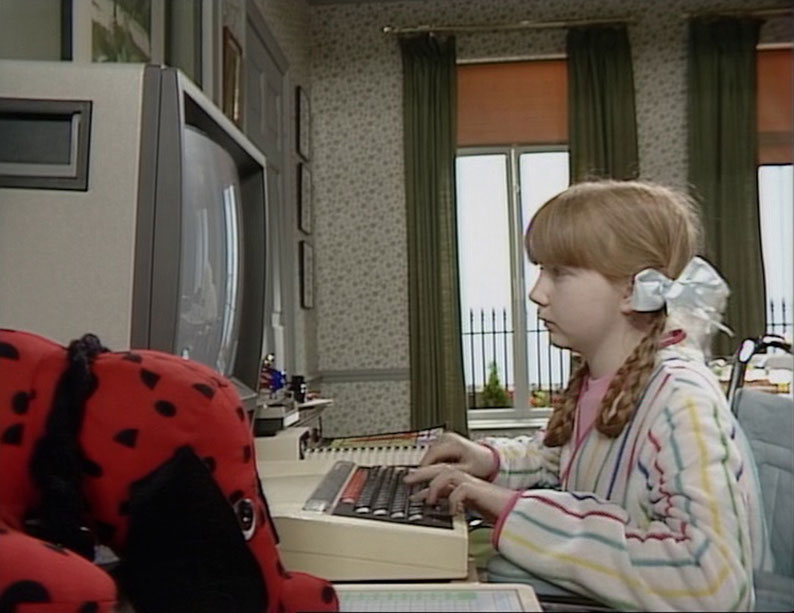
The film's low profile is surprising because it surrounds its young first-cinema-time lead actress with one of the starriest casts in any CFF or CFTF production: as well as Kelly and Hunt, we have Eric Sykes, Windsor Davies, Lynsey de Paul and such familiar supporting artists as Josephine Tewson and Bob Todd, all playing multiple roles. As children's film matinees were becoming a thing of the past, it's likely that this film would have seemed too lo-fi to compete with the special-effects-laden blockbusters in the cinema, such as Tron, to which this bears some resemblance. Gabrielle and the Doodleman is a curio, but a not unentertaining one.
The BFI's release of Children's Film Foundation Bumper Box Vol. 4 comprises three dual-layered DVDs, encoded for all regions. There are three features and two shorts on each disc.
Eight of the nine feature films and all of the supporting shorts had U certificates on their original releases. Most of them retain that rating but four – The Stolen Airliner, The Big Catch, Blinker's Spy-Spotter and Mr. Selkie – are now PG. That's also the case with Gabrielle and the Doodleman, which hadn't been submitted to the BBFC before now. The two documentaries on Disc Three have been exempted from certification, though Our Magazine No. 4 was a U in cinemas.
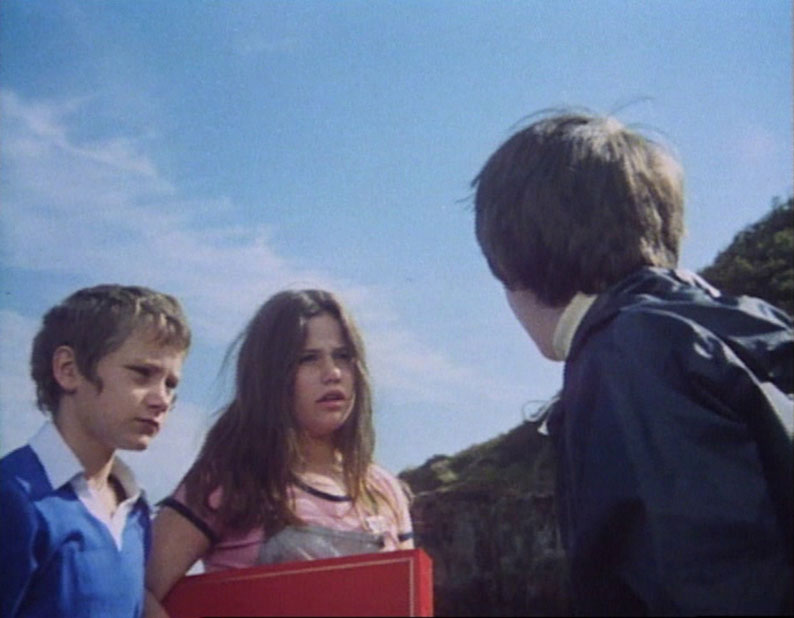
Mr. Selkie
All of the films have been transferred at a ratio of 1.33:1, except for Blinker's Spy-Spotter, The Flying Sorcerer and The Chiffy Kids: Pot Luck, which are 1.66:1 and anamorphically enhanced. The newly-produced documentary London Locations is 1.78:1, also anamorphic. I'll repeat the comment I made in my review of Volume 3. While Academy Ratio (which is actually 1.37:1) is undoubtedly correct for the three supporting shorts on these discs made in 1952, I'm less convinced it's correct for the features. 1953 was the year the UK and US cinema industries converted to widescreen, at least for commercially-intended films shot in 35mm. By the end of the year, Academy was obsolete in favour of several different ratios (depending on which studio a film was shot at), which by 1955 had settled to an industry projection standard of 1.75:1 for non-Scope films. (It's often assumed that British films were predominantly 1.66:1, but going by the trade publications of the time, this would seem to be a myth.) Films were mostly shot open-matte (i.e. exposing the full height of the negative), even if shots were composed so that projector aperture gates would crop the image at the top and bottom to achieve the intended ratio, both for the benefit of those few cinemas which were slow to convert to widescreen, and also to avoid black bars appearing top and bottom when films were later shown on television, which remained a 4:3 medium for four decades more. The Dog and the Diamonds, which was released in November 1953 would have been made right on the cusp of the changeover, so Academy could be correct for that film, though it's not tightly composed if that's the case. However, the large amount of headroom in the later films in this set is a giveaway that they would be projected at a wider ratio than Academy as once cinemas converted, there was no going back: the cinemas which could still show 1.37:1 were arthouses and repertory screens and very few others. I have no way of telling, but I wonder if the 1.66:1 films in this set were shot with a hard-matte (with an aperture gate in camera) into that ratio. Gabrielle and the Doodleman, shot on video as a television production, may well be intended to be shown in 4:3 as well.
As for the transfers themselves, they are mastered from "the best available materials held by the BFI National Archive". The booklet notes aren't more specific than that, but it's clear that the sources vary in condition. The oldest feature, The Dog and the Diamonds, seems to have suffered particular damage, as quite a few shots and sequences have been transferred from a source that's a lot softer than the rest of the film, and there are some scratches too. Mr. Selkie is darker, more contrasty and grainier than the other films, which suggests it was transferred from a later generation from the original negatives likely used elsewhere. Gabrielle and the Doodleman was shot on video, and looks fine, pretty much what you'd expect from standard-def video from the time, inevitably rather flatter in look and lighting from the other films, which were all shot on 35mm film.
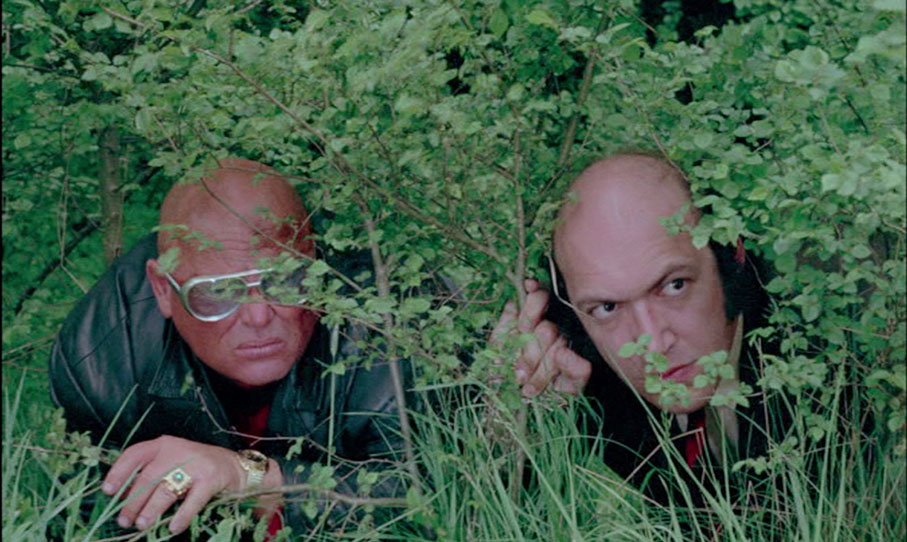
Blinker's Spy-Spotter
As these are PAL DVDs, they play at twenty-five frames per second, instead of the twenty-four they would have been shot in for cinema showings. This does mean that each feature on these discs runs short of the cinema running time by around two minutes, or by about a minute in the case of the shorts, and if you have perfect pitch (I don't), the music will be raised by half a semitone. There's a giveaway that twenty-four fps was the production speed in Blinker's Spy-Spotter: every shot of the device of the title in action shows a television screen with rolling bars.
The soundtracks are mono, rendered as Dolby Digital 2.0, except for London Locations, in which the music plays in surround. The tracks are clear and well-balanced, and the dialogue, whether in RP or not-too-strong regional accents, is well-enunciated. There's a moment forty-three minutes into The Big Catch when the soundtrack drops out while someone is clearly still speaking. Unfortunately there are no hard-of-hearing subtitles available.
Stable Rivals (15:03)
As well as the main feature, Saturday morning picture shows also featured a number of shorter films, either single-reel comedies and dramas or documentaries. Stable Rivals dates from 1952 and if you wanted to produce a parody of a CFF production you might end up with something like this: a rivalry between rival children (speaking in cutglass accents) over a forthcoming gymkhana. In style it falls squarely between something children would like to watch and something their parents think they ought to watch without really satisfying as either.
Swift Water (15:05)
Also from 1952, Swift Water is the story of townie Terry (Guthrie Mason) who has adventures while on holiday on the banks of the River Dart, where he discovers the joys of birdwatching (of the avian variety) and sailing, defying over-protective Auntie. It's mild stuff but not disagreeable.
The Chiffy Kids: Pot Luck (19:02)
Serials formed part of the CFF's repertoire. The Chiffy Kids was not so much a serial as a series of short adventures, twelve of them all told, of which this one, from 1976, was the first. In this case the main title is The Chiffy Kids with the episode title Pot Luck sharing a card with the writing credit. A five-piece ensemble have adventures camping in the countryside, though I suspect parents would frown upon tieing up the youngest and putting her in a cooking pot. Another pretends to be a ghost. Adult interest is provided by Harry H. Corbett as Hungry Herbert, a farmworker who (boo hiss!) steals the children's sausages.
Chimp-Mates: The Big Kick (16:31)
One of the more high-concept CFF productions, this 1976 film (again with the overall title first and then with the episode title sharing the writing credit) features Alice the Chimp who joins a local football team. One of the three human child leads is Dexter Fletcher, in an early role, before going on to an acting and directing career as an adult. The football team featured is the non-league Sipson Athletic.
A CFF Production: London Locations (13:57)
This is a newly-produced documentary, in which twelve-year-old Edward Molony takes us round the locations of four London-based CFF productions, comparing them with the way they look now and sometimes revealing the sleight of hand involved in moving from one street to another not actually directly connected to it. The four films featured are The Boy Who Turned Yellow (1972), The Monster of Highgate Ponds (1961), Night Ferry (1976) and Operation Third Form (1966). The framing material is presented in a ratio of 1.78:1 with the film extracts in 1.66:1 for The Boy Who Turned Yellow and 1.37:1 for the other three. Clips from a few other London-based CFF productions, with the relevant locations indicated, are included at the start of this documentary.
Our Magazine No. 4 (9:49)
And finally, some documentary to leaven the drama and comedy. This was one of a regular series of short films containing short magazine items. So we move from traffic drills in in Harrow to iron-making in tribal Africa, from Great Dane grooming to cowboy Cal McCord demonstrating some rope tricks, all to a rather paternalistic voiceover.
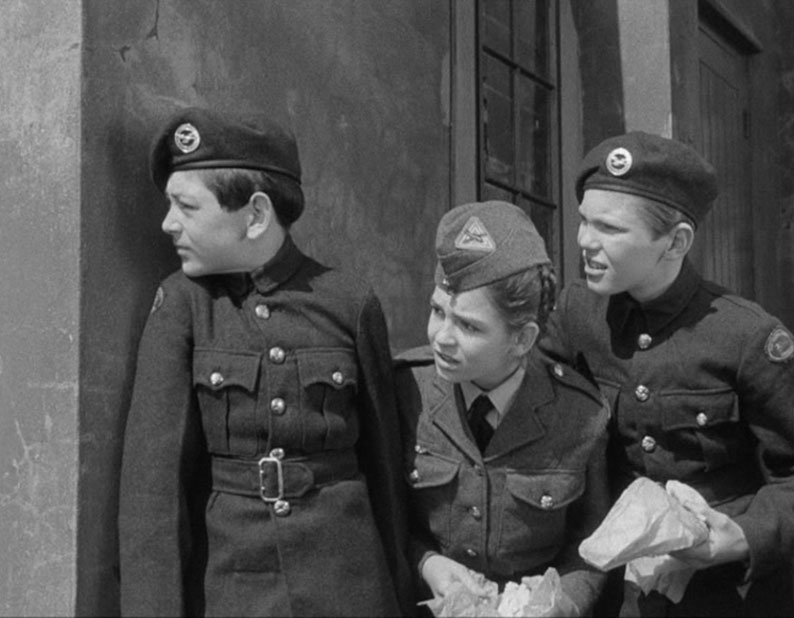
The Stolen Airliner
Booklet
The BFI's booklet, available with the first pressing only, comes in at thirty-two pages. Vic Pratt begins with an essay, "Rise and Shine with the Fourth Fabulous Fun-Filled CFF Bumper Box!". The tone of this is rather set by that title: more than a little tongue-in-cheek and tending towards kitsch. It gives an overview of the CFF's history, its efforts to move with the times (not so much middle-classness, for example), before it ceased operations.
Pratt writes the notes for all of the films in this set, striking pretty much the same tone throughout, with the exception of the newly-made London Locations documentary, which is given over to its director Jason Gurr. Two further items refer specifically to Mr. Selkie: a short piece by Samantha McCallum (née Weysom) talking about her memories of making the film at age twelve. The booklet also reproduces a letter to her by production controller Ron Appleton, inviting her to make a personal appearance at showings of the film in 1979. Secondly, Diana Manthey pays tribute to her father John Tully, a prolific screenwriter, including several CFF productions, and novelist. Finally, just to make sure you were paying attention, Trevona Thompson asks nine questions, one on each of the main features in this set, plus a bonus question, Screen Test style. The booklet also includes plenty of stills.
These films and others like them kept British youngsters entertained for three and a half decades, though you do have to wonder how much they would appeal to present-day children rather than to their nostalgic parents or even grandparents or to anyone with an established interest in social history, particularly regarding children's entertainment. There's a tone to this box set which suggests the latter.. However, with nine features, five shorts and a newly-made documentary, you can't complain about value for money and with the inevitable limitations of the some of the source material, it's well put together by the BFI.
|